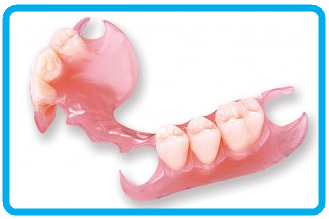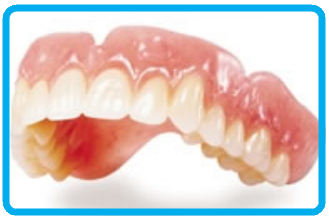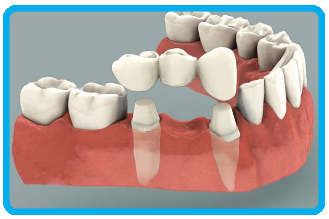

Missing Teeth
Replacement
When teeth are missing, it can affect the way the rest of your teeth bite together. Your remaining teeth may tilt and drift into the gaps and food can get trapped in the spaces, increasing your risk of tooth decay and gum disease. When many teeth are missing, your facial muscles can become saggy, affecting your speech and appearance.
Replacement teeth are made to match the colour of your natural teeth as closely as possible.
If you have missing teeth, you may choose to do nothing and
leave the space empty. Alternatively, you may want to have your
missing teeth replaced. There are several different treatment
options available.
The most appropriate treatment will depend on the number of teeth
that are missing, where they are in your mouth and the condition of
any remaining teeth. Your dentist will help you decide which option
is best for you.
Partial Dentures
A partial denture can be used to replace one or more missing teeth. A partial denture is a framework (plate) with a number of false teeth on it.
There are different types of partial dentures, but they commonly include a metal and/or plastic plate with plastic or porcelain false teeth. Partial dentures often have metal clasps. Where possible, these clasps are hidden so that they can't be seen when you smile or talk. Alternatively, your dentist may recommend flexible (or soft) partial dentures. These adapt around the shape of your teeth and gums and can be used when it’s difficult or impossible to fit a plastic or metal denture.
Complete Dentures
Full (or complete) dentures are needed when you have no teeth left in your upper or lower jaw. They are usually made of a plastic plate with plastic teeth.
Full upper dentures cover the roof of your mouth (palate). A very thin layer of saliva between your palate and the denture creates suction, which keeps it firmly in position. Your facial muscles and tongue also help to keep it in place.
Full lower dentures are often more difficult to keep in place because the floor of your mouth moves a lot, and the ridge where your teeth used to be shrinks with age.
If only one or two teeth are missing, your dentist may recommend a bridge. He or she will attach a false tooth (or teeth) to your natural teeth on either side or occasionally on only one side of the gap.
Bridges are made of porcelain and/or metal. There are many bridge designs. The natural teeth on either side of the space are specially prepared for the crowns to fit on top. These crowns are permanently attached to a false tooth in the centre.
Bridges are cemented in place, so you can’t remove them for cleaning. To keep your natural teeth healthy, you should clean the gap under a bridge with a special dental floss. Ask your dentist or hygienist to show you how to floss under your bridge. On average, bridges last between five and 10 years.
Click Here for information on Dental
Implants




S.N
Prasad
Patient ID: 093
Treatments Received:
Dental Implant, Root Canal
Treatment & Extraction
Rating: ***** (5/5)
Best place in Ranchi to get Dental treatment. My Implants, Root Canal, Extraction and a bridge work was so painless, I hardly felt anything. Recommended!


Smiles Central
Kadru
Road,
Near Ashok Vihar Gate
Opp.
Manoj Opticals, Ashok Nagar,
Ranchi 834002
Tel: +91-8797671414
E-mail:
contact@smilescentral.in